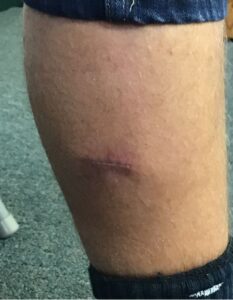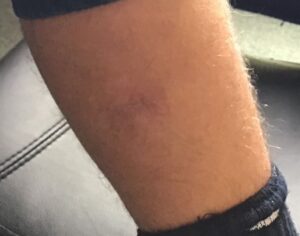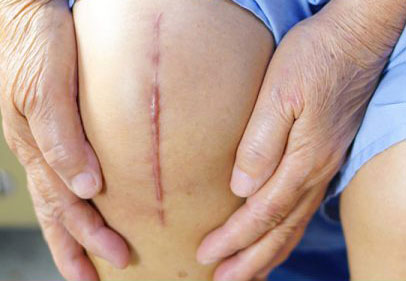The Magic Eraser for Scars
Surgery’s Leave-behind, the Scar
The scar tissue is at fault they say … Yes, the scar tissue can be a source of discomfort and restricted movement, not to mention how it looks.
Different than other professionals, we restore the movement to and across the area affected by the surgery. When the affected area can move freely, we find the scar tissue begins to soften on its own. The scar had an important job; now that job is done and the movement needs help returning to normal.
Let’s take a look at a real example

This client came in for a tune-up and mentioned he had a skin lesion on his calf removed about 6 weeks ago. (See before picture–the incision is still puckered and red.)
The movement implications — his leg was stiff compared to the other leg. The hip didn’t rotate fluently nor did the ankle/knee/hip flex sequentially.

After 15-20 minutes of Bridging movements applied to the overall leg we rechecked the leg. We found the hip rotated easily and the leg flexed sequentially, just like it’s supposed to. Even more amazing is the change to the scar — it’s smoother and the coloration is neutralized. (See the after picture.)
Why did the scar change without specific attention?
First let’s step back and think about what happens with an incision–some amount of tissue is cut, removed, and rearranged in order to put it back together. The entire area has been disrupted and remains fragile (not moving) as it heals. What most people don’t realize is the movement in the area doesn’t magically re-set itself once healed.
There are two aspects of this shut down movement — the overall movement and the interconnected micro-flows within the affected area.
- Overall movement: In our example above, the stiffness with hip rotation and leg flexion typify how movement itself is compromised. (He was walking but hadn’t felt like working out since the procedure.)
- Micro-flows: The various layers of tissue structures within the area of the procedure were impacted. This includes skin, fat, muscle, nerves, fascia, blood vessels and lymphatic structures which all have well orchestrated micro-flows. These relate to the puckered texture and discoloration.
The light oscillatory movement of Bridging enables all of these elements to shift slightly, helping both the movement and internal micro-flows return to normal. The skin tension then calms and restored circulation flows clear away the residual particles and fluids related to the discoloration. It really does seem like a magic eraser!
Will it last? We find many scars are nearly gone when we see a client again weeks later. The restored movement is the key for the affected area returning to normal.
What if the scar is from years ago? These old wounds can still inhibit movement and tissue flows. They do change.
A memorable change was a teen’s tracheotomy scar in the center of her neckline from an infant procedure 12 or so years prior. The discoloration significantly faded and the textured area became so smooth it is now barely noticeable. She no longer feels like she has to cover the area up to avoid attention.
Does this sound like something you or a loved one are experiencing? We can help.
Check out our website for more info about post-surgical support.

